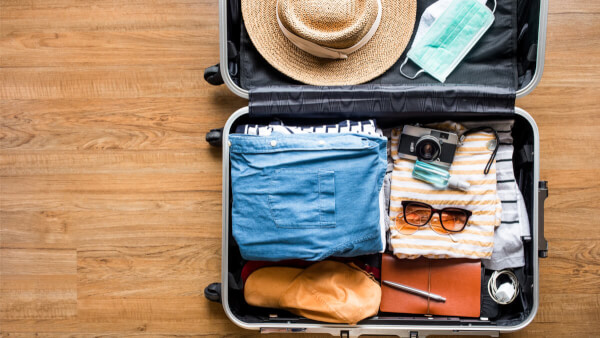UBank vs Wise card - Which is the better travel card to use overseas in Australia?
Looking for a travel card to use overseas? We compared the fees, features, and benefits of two top travel cards: Ubank vs Wise, for Australian travellers.

For many of us, a holiday abroad is the highlight of the year. But the happy glow can give way to frustration if you find you’re hit by unnecessary and expensive bank fees and charges while you’re away. If you’re planning a trip, avoid this by thinking in advance about the best way to pay your way while you’re travelling. Debit or credit cards are often the most convenient and safe option. However, it’s important to understand the fees and charges which will be added to your overseas spending before you go. By avoiding some of the common pitfalls, you can quite easily make sure your money goes further.
Read this guide to find out:
You can use your Santander credit or debit card while you’re away, just the same as you might at home. You can even use your contactless card wherever you see the contactless symbol displayed. However, not everywhere has adopted contactless technology yet, so you may be out of luck.
With most Santander cards, you’ll find that there are additional fees to pay when you use your card overseas. You should also bear in mind that cash is still the main form of payment in some countries. If your holiday is somewhere exotic, then taking some cash with you might be a sensible idea, too.
Whether you choose to spend abroad using your debit or credit card, you’re going to incur some fees.
There are some big variances in the fees charged for different bank cards issued by Santander. To figure out what it’ll cost for you to use your card overseas, the first thing you have to know is whether your card is a Visa or a Mastercard. Although Santander has issued your card, they then rely on one of these companies to process transactions for them. That means that either Visa or Mastercard are in charge of calculating the exchange rate applied to your purchases while you’re away. You can find out easily which your card uses by looking for the symbol on the card itself.
For example, let’s say you have a Santander Visa debit card. Whenever you spend, the bank will apply the day’s exchange rate as calculated by Visa, to convert your purchase into GBP. You can expect a small markup to be added from the real exchange rate you’d find on Google. But usually the rates are pretty fair, as long as you’re being charged in the local currency. If you end up being charged in GBP you might run into exorbitant mark-ups because of something called Dynamic Currency Conversion (DCC). But more on that later.
If you hold several different cards and aren't sure which to use while you’re abroad, then it might help to know that analysts who have reviewed the exchange rates offered over time reckon that Mastercard offers marginally better rates. However, the differences are fairly small and vary depending on where you are, and which currency you’re spending in. You can see how your card exchange rate compares to the real mid-market rate, using an online currency converter.
If you want to find out more, you can find the daily exchange rates being used between different currencies by Visa and Mastercard on their websites below:
On top of any exchange rate markups, Santander will then deduct its cut, which is known as a non-sterling transaction fee, non-sterling purchase fee or a non-sterling cash fee.
If you’re taking cash out of an ATM, there may also be further charges to pay. Santander adds an extra fee of at least £1.99 - and in some cases much more - when you use most of their cards abroad, and individual banks or ATM providers might levy their own fees on top of those your bank charges.
Remember Dynamic Currency Conversion (DCC), mentioned above? This is when you’re asked if you want your purchase to be processed in GBP instead of the local currency. It might seem like a simple convenience, but should most definitely be avoided.
You’ll run into DCC nearly anywhere your card is accepted overseas. For example, at an ATM, restaurant or store. Always choose to pay in the local currency, because the foreign currency exchange rates applied when using DCC are always pretty poor. In this case, the rates are set by the local company or ATM machine. Unlike your bank, which has an interest in ensuring you’re happy with their services, a foreign provider, has no such obligations. They’ll mark-up the exchange rate so they can pocket the difference, meaning you pay over the odds for no real benefit.
The costs are worked out in a similar way if you use a credit card, but you’ll also have to pay any interest charges you might incur. Don’t forget, there’s no grace period on currency withdrawals on a credit card, so you start to pay interest as soon as you have got your cash.
The exact fees you’re liable for will be detailed online or on the back of your card statements. These below are a guide, because different card types might have some variances. For example, with the Gold Visa debit card, you’ll find you can get fee free ATM withdrawals from Santander machines in most countries, and the World Elite Mastercard means you don’t get charged foreign transaction fees, as long as you steer clear of DCC.
Here are the fees you’ll be charged to use your Santander credit or debit card while you’re away:
| Santander Debit Card | Santander All in One Credit Card | Most other Santander Credit Cards | |
|---|---|---|---|
| Purchases - ATM Usage and buying travellers cheques | Purchases - ATM Usage and buying travellers cheques | Purchases - ATM Usage and buying travellers cheques | |
| Non-Sterling Transaction Fee | 2.75% - 2.75% | 0% - n/a | 2.95% - 2.95% |
| Non-Sterling Purchase Fee | £1.25 - n/a | n/a - n/a | n/a -n/a |
| Non-Sterling Cash Fee | n/a - 1.5% (minimum £1.99) | n/a - 3% (minimum £3) cash withdrawal fee | n/a - 3% (minimum £3) cash withdrawal fee |
Both Visa and Mastercard have handy online calculators to help you work out what you’ll actually be charged if you make purchases abroad. Say for example, that you spend EUR 100 on a wild night out in Berlin, and use your Santander Visa credit card (not an All in One card). The exchange rate applied, which takes into account non-sterling transaction fee charged by your card provider applied could have looked like this:
Using this exchange rate, the final bill you’ll see on your statement totalled £90.79. The exchange rate used will fluctuate, of course, so it’s worth checking the online tools regularly.
🌏 Heading abroad? Compare the best travel cards in our guide for the smartest way to spend overseas.
It’s worth thinking about how you’ll cope if your card is somehow lost or stolen when you’re on your holiday.
Whatever has happened, if you lose your card when you’re abroad, you must contact Santander immediately to report the loss.
Exactly how Santander is able to help you, depends a little on the type of card you hold. They’ll cancel the card and allow you to order a new one in all cases, but if you hold one of the premium cards, you might also qualify for more support. For example, if you have a 1|2|3 Current account and a Gold Visa, you can get quick emergency cash in most cases, and if you have a World Elite Mastercard, you could be provided with a replacement card in as little as 2 days.
To report your card missing, use these details:
If you don’t qualify for the more premium protection offered by Santander, you can get card protection insurance which could be handy if your card is lost or stolen while you’re abroad. This can be arranged through your bank or by using an insurance company. However, this will come at a fee. If you do take this additional protection, make sure you have all your policy details with you when you travel, just in case.
Your personal preferences and spending habits will dictate whether it’s best to use a debit or credit card abroad. It’s also important to understand the fees and charges associated with your specific Santander card, as there are some big differences between the best and worst value when used overseas.
Using a debit card is better if you intend on taking out cash from an ATM. That’s because the non-sterling cash fee is lower when using a debit card. Watch out, however, for extra fees added by the local ATM.
However, a credit card might suit you if you need to spread the cost of your holiday over time. Depending on which credit card you have, you could even get a better deal, or be eligible for discounts on additional services such as travel insurance. You might rack up additional interest costs, though.
Spending on a credit card can be safer than using cash, as your purchases will be monitored by your bank. You should also be able to get help if you're the victim of fraud. To get the most out of this option, keep all your receipts and check your card statements thoroughly.
Santander asks customers to inform them if they’re travelling outside of the EU. It’s not compulsory, but it might avoid hassle if the anti-fraud systems pick up unusual spending patterns. What’s most important, is that Santander has the right contact details for you. If the bank systems think they see any suspicious activity, they’ll phone you to check everything is okay. If they’ve got the wrong number, or you have your phone turned off while you’re abroad, your account activity might be blocked entirely, or limited while they make further checks.
Whatever card you decide is best to use while you’re away, it’s well worth having a secondary bank card just in case. Keep some local cash on you at all times in case you find that cards aren’t accepted.
Of course, it can be tough to keep track of your spending when you’re on holiday. You might also find you accidentally overspend while away because you lose track of the costs in another currency. Santander offers email and text alerts to keep you up to date with how much cash is left in your account. This is worth considering - or you can try an app to monitor and manage your cash flow while you’re away. Setting yourself a daily spending limit is another simple way to make sure you don’t have any nasty surprises once your holiday is over.
You shouldn’t need to worry about money while you’re on holiday. Luckily, if you use these tips, and make sure you know before you go, which method of payment is going to be best for you, you shouldn’t need to worry about unexpected charges. All you have to do is relax and enjoy!
*Please see terms of use and product availability for your region or visit Wise fees and pricing for the most up to date pricing and fee information.
This publication is provided for general information purposes and does not constitute legal, tax or other professional advice from Wise Payments Limited or its subsidiaries and its affiliates, and it is not intended as a substitute for obtaining advice from a financial advisor or any other professional.
We make no representations, warranties or guarantees, whether expressed or implied, that the content in the publication is accurate, complete or up to date.

Looking for a travel card to use overseas? We compared the fees, features, and benefits of two top travel cards: Ubank vs Wise, for Australian travellers.

The most cost-effective ways to get foreign currency. Compare banks, exchange services, and ATMs with tips to avoid hidden fees and get the best exchange rates.

Planning to use your UBank card to make ATM withdrawals internationally? Read on to understand the true cost of overseas transactions with UBank.

Wondering if Travel Money Oz is the right solution for you? Our guide outlines everything you need to know about their currency exchange and travel money cards.

If you're trying to decide between Travelex and Travel Money Oz for your international money needs, read on for our side-by-side comparison of the features.

Side-by-side Comparison of Westpac Travel Card vs Wise Travel to help Australian users decided which is a better travel card for spending abroad.